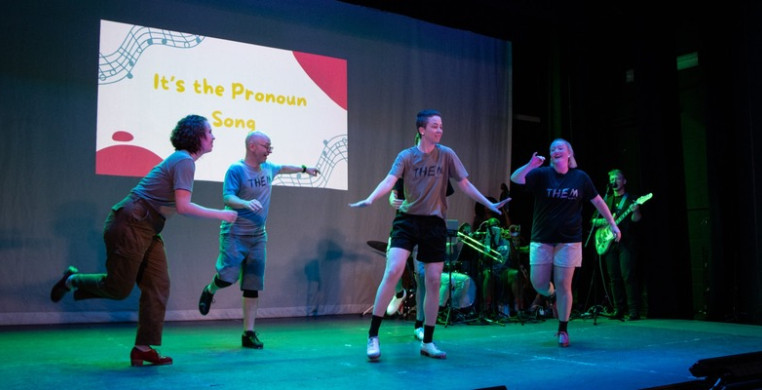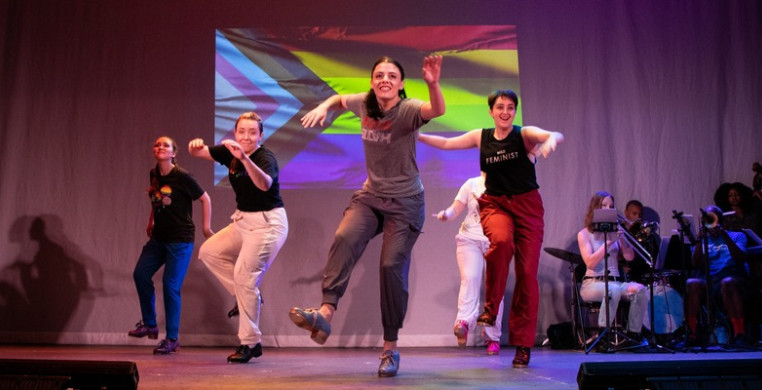UPDATE: The new seechicagodance.com will launch March 31st. Click here to learn more.
“Can You Hear Us Now?”; Connection between queer identity and tap dance
In a whirl of rhythm and grace, “Can You Hear Us Now? The Queer Tap Dance Revolution,” performed by Chicago Tap Theatre (CTT) on June 20, celebrates diverse identities and tap dance history through movement, sound and unbridled emotion. First-time director Molly Smith curates a show that underscores the remarkable similarities of queer identity and tap dance in this glorification of individuality, resilience against adversity and the power of self-expression. Great tap dancers and musicians who either identified as LGBTQ+ or worked towards breaking down barriers of gender were honored throughout the evening through projected slides and tributary works.
The evening opens with a powerful full-cast performance of “Down This Road We Go,” choreographed by Sara Anderson. Through innovative use of space, Anderson weaves a narrative that juxtaposes tradition with modernity, seamlessly blending elements of jazz-age elegance with contemporary energy. The dancers enter the space with steady walks that begin to unfold into more complex rhythms, building into a copacetic beat as more dancers arrive. The sharp, percussive beats punctuate the air, and as the dance evolves so does the passion of the performers. However, as a cohesive unit, the dancers seemed slightly disjointed, and despite their individual talents moments of misalignment and timing issues detracted from the overall impact. Nevertheless, their enthusiasm and commitment shone through, leaving the audience moved by the artistry displayed.
In “Juanita Pitts,” the back of the stage lights up with a black and white video projection of a tap dancer performing in a white tuxedo and oxford shoes. Although one might assume that the dancer is a male from their attire, tap historians will know this is a video of barrier-breaking female tap dancer Juanita Pitts, who despite her talent, spent much of her career dancing in relative obscurity.
 “Juanita Pitts," Sterling Harris and Molly Smith; Photo by Mollie Menuck
“Juanita Pitts," Sterling Harris and Molly Smith; Photo by Mollie Menuck
Molly Smith honors the trailblazer in a duet with Sterling Harris, and the two pay homage to her legacy with syncopated rhythms. Dressed in timeless white tuxedos reminiscent of Pitts’ iconic style, the dancers breathed new life into her legacy for a contemporary audience. Through their synchronized movements and heartfelt expressions, the duet embodied the enduring influence of Pitts.
Molly Smith performed a poignant improvised tap solo set to queer artist Brandi Carlile’s “The Story,” sung by THEM Queers vocalist Nate Kistler. With each resonant tap and nuanced shuffle, Smith channels the song’s lyrics, expressing themes of resilience, introspection and personal growth. As the melody builds, so does the intensity of their performance, capturing moments of vulnerability and triumph with each intricate rhythm. This solo performance is a resounding heartfelt exploration of Smith’s journey through their own queer identity, leaving an indelible impression of catharsis and authenticity.
Two pieces stood out for their light-hearted and silly demeanor. Dancers act as tap robots in “If I Was A Belle,” choreographed by artistic director Mark Yonally. As the dancers prance around the stage, arms held rigidly in front of them, one by one they break out of their form, stepping into a splash of colored lighting which propels them into a whirlwind of individualized improvisation. With exceptional acting by dancers Sara Anderson, Michelle Haskell, Liora Lahav and Davon Suttles, their journey unfolds as a testament to the power of creativity and the resilience to embracing one’s identity, proving that even in a world of technology and conformity, the pursuit of individuality and artistic expression knows no bounds.
 “Pronoun Song," with Sara Anderson, Mark Yonally, Molly Smith and Amber Buchanan; Photo by Mollie Menuck
“Pronoun Song," with Sara Anderson, Mark Yonally, Molly Smith and Amber Buchanan; Photo by Mollie Menuck
“Pronoun Song,” about the use of they/them pronouns, sung live by THEM Queers vocalist Nate Kistler, combines educational lyrics with rhyme. The upbeat melody, projected on the back of the stage as a sing-along, playfully emphasized the importance of respecting gender identity and encouraging everyone to embrace inclusive language. The dancers’ energetic footwork, choreographed by Smith, echoes the song’s playful tone, punctuating each beat with exuberance and flair. The performance is a vibrant celebration of diversity, blending music and dance to create joy that hopefully inspires audience members to be more aware of their pronoun usage in everyday life.
Both tap dance and the queer community have historically faced challenges in gaining recognition and acceptance yet have persevered through creativity and passion. Tap dancers, like LGBTQ+ individuals, often use their art to challenge norms and communicate personal stories, fostering a sense of community and empowerment. At their core, both celebrate the beauty of authenticity and the freedom to express oneself openly and proudly. Whether through intricate rhythms or diverse identities, tap dance and the queer community exemplify the strength found in unity and the richness of embracing one’s true self.


